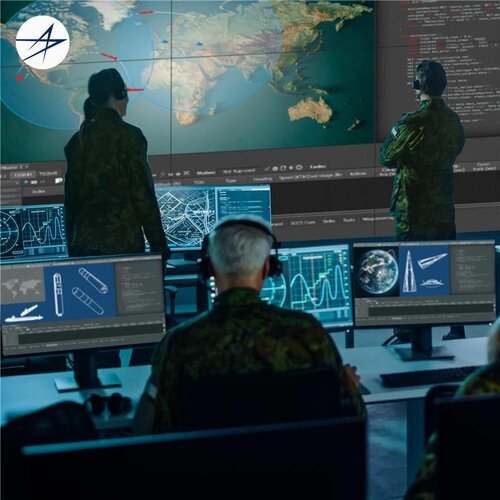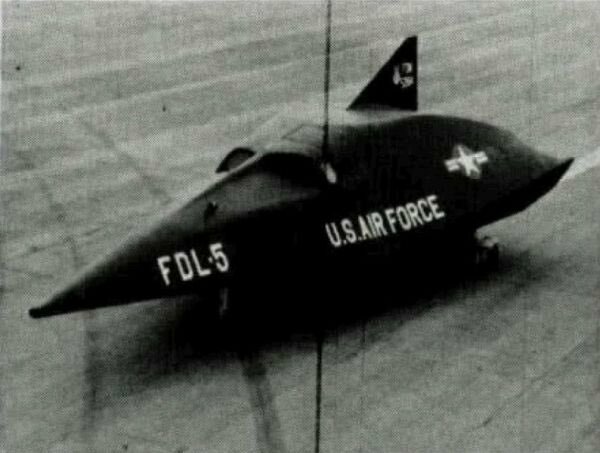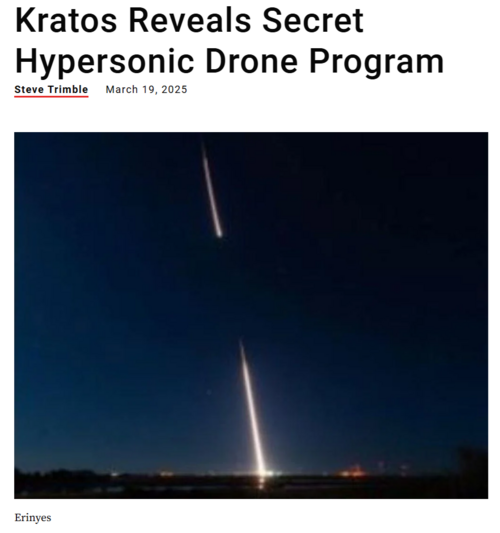You are using an out of date browser. It may not display this or other websites correctly.
You should upgrade or use an alternative browser.
You should upgrade or use an alternative browser.
Current US hypersonic weapons projects. (General)
- Thread starter Hanse
- Start date
but we never even figured out what hCCW stood for…
I suppose the "H" stood for hypersonic and the "W" stood for weapon.
dark sidius
ACCESS: Top Secret
- Joined
- 1 August 2008
- Messages
- 1,191
- Reaction score
- 1,059
dark sidius
ACCESS: Top Secret
- Joined
- 1 August 2008
- Messages
- 1,191
- Reaction score
- 1,059
yeetmahboi
ACCESS: Secret
- Joined
- 6 April 2022
- Messages
- 476
- Reaction score
- 565
I wish it was CAV. But reality strikes hard.What is this interesting thing on the right screen ?View attachment 762112
Probably just a generic HGV design. Don't read too much into it.
Forest Green
ACCESS: Above Top Secret
- Joined
- 11 June 2019
- Messages
- 9,362
- Reaction score
- 17,045
Looks sort of like the LS-200.
dark sidius
ACCESS: Top Secret
- Joined
- 1 August 2008
- Messages
- 1,191
- Reaction score
- 1,059
Anti missile hypersonic glide vehicle ?Looks sort of like the LS-200.
Forest Green
ACCESS: Above Top Secret
- Joined
- 11 June 2019
- Messages
- 9,362
- Reaction score
- 17,045
Orbital stealth bomber.
dark sidius
ACCESS: Top Secret
- Joined
- 1 August 2008
- Messages
- 1,191
- Reaction score
- 1,059
It could be a beautiful capacityOrbital stealth bomber.
- Joined
- 21 April 2009
- Messages
- 13,718
- Reaction score
- 7,599
Starship loaded with 100 1k lbs RVs would be a nice capabilityIt could be a beautiful capacity
dark sidius
ACCESS: Top Secret
- Joined
- 1 August 2008
- Messages
- 1,191
- Reaction score
- 1,059
We don't know what lockheed could have in mind...Starship loaded with 100 1k lbs RVs would be a nice capability
Forest Green
ACCESS: Above Top Secret
- Joined
- 11 June 2019
- Messages
- 9,362
- Reaction score
- 17,045
Lobbing C-HGBs without the missile.Starship loaded with 100 1k lbs RVs would be a nice capability
In_A_Dream
ACCESS: Top Secret
- Joined
- 3 June 2019
- Messages
- 669
- Reaction score
- 681
What does Project Mayhem look like?
Like attempted destruction of banking and financial institution infrastructure in hope it would push the consumerism driven society into chaos?What does Project Mayhem look like?
dark sidius
ACCESS: Top Secret
- Joined
- 1 August 2008
- Messages
- 1,191
- Reaction score
- 1,059
Last edited:
yeetmahboi
ACCESS: Secret
- Joined
- 6 April 2022
- Messages
- 476
- Reaction score
- 565
It’s just fan fiction. The USAF is struggling just to build a new fighter.
dark sidius
ACCESS: Top Secret
- Joined
- 1 August 2008
- Messages
- 1,191
- Reaction score
- 1,059
We know nothing about the Lockheed or USAF black programs a lot is possible behind the wall. A lot is surely done since the Darpa Falcon hypersonic of 2006, now Darpa have a new one with the NEXTrs we absolutly dont know where they are with the hypersonics technology we can speculate but for sure a lot of work have been done since 2006.It’s just fan fiction. The USAF is struggling just to build a new fighter.
- Joined
- 21 April 2009
- Messages
- 13,718
- Reaction score
- 7,599
I think sometimes our optimism can blur our vision. I’ve generally been a technological optimist thinking “there has to be, half a trillion plus black budget over the decades later, something out there”
One of the “optimistic fallacies” I fall into is “the reason they’re debating the form and function of 6th Gen aircraft is there’s a plane so advanced in the black we should wait for that”
Unfortunately my thinking is becoming more pessimistic that we can’t do a lot of the things we did before, anymore, ships, aircraft, ICBMs, etc.
One of the “optimistic fallacies” I fall into is “the reason they’re debating the form and function of 6th Gen aircraft is there’s a plane so advanced in the black we should wait for that”
Unfortunately my thinking is becoming more pessimistic that we can’t do a lot of the things we did before, anymore, ships, aircraft, ICBMs, etc.
yeetmahboi
ACCESS: Secret
- Joined
- 6 April 2022
- Messages
- 476
- Reaction score
- 565
I'd be happy if the US can churn out ships like they used to. But even that is too much of an ask with how the industry have degraded.Unfortunately my thinking is becoming more pessimistic that we can’t do a lot of the things we did before, anymore, ships, aircraft, ICBMs, etc.
In an alternate universe the US never saw the devastating changes brought by the immediate 90s era. The first men and women would be exploring Mars and space warfare comes as a nice bonus. Reality? Wall Street wants to wave stock evaluation papers around to beat the centuries-worth oil storage under mega industrialized Russia?
SRAM took 8 years from contract formulation to operational fielding. ARRW is cancelled after 6 years but the glider is already over a decade old. And now we have nearly zero nuclear SOW for the B-2/21 force. Politicians like to point out how some weapon will cost billions to develop and billions to field. Yet they neglect to mention how crucial the fielding of those weapons to the security of those billions of dollars or how some social welfare program is still practiced despite demonstrated futility, programs that cost multiple magnitudes more than the "scary rockets".
Defense Updates has put out a video about whether or not the Dark Eagle will be a game-changer for the US:
After years of delays and technical challenges, the U.S. Army is gearing up to deploy its much-anticipated "Dark Eagle" long-range hypersonic weapon (LRHW) by the end of fiscal year 2025. This update follows a recent U.S. congressional report, confirmed by a defense official to Defense News, stating that the Army aims to field the first LRHW unit within the next year.
The original plan was to equip the 1st Multi-Domain Task Force, 5th Battalion, 3rd Field Artillery Regiment, 17th Field Artillery Brigade at Joint Base Lewis-McChord, Washington, with the LRHW by fall 2023. However persistent issues with the launcher and launch sequence forced the Army to push back its timeline. A government watchdog report previously pointed to these technical difficulties as a major factor behind the delays, noting that while the missile itself remained functional, complications with the firing mechanism and range conditions led to several aborted tests.
In this video, Defense Updates analyzes why the “Dark Eagle” long-range hypersonic weapon (LRHW) will be a game changer for the US military?
- Joined
- 21 April 2009
- Messages
- 13,718
- Reaction score
- 7,599

US Approves $200M Deal to Aid Japan’s High-Speed Weapon Development
The US State Department has approved a $200-million deal to aid Japan’s Hyper Velocity Gliding Projectiles program.
 thedefensepost.com
thedefensepost.com
Forest Green
ACCESS: Above Top Secret
- Joined
- 11 June 2019
- Messages
- 9,362
- Reaction score
- 17,045

Varda launches third space capsule to advance hypersonic navigation tech
Los Angeles CA (SPX) Mar 17, 2025 - Varda Space Industries, Inc., a company focused on microgravity-enabled life sciences and atmospheric reentry solutions, has successfully deployed its third orbital capsule, W-3, marking its second
www.spacewar.com
Gen. James Rainey, the head of Army Futures Command said it must stop buying equipment that is "expensive but not exquisite" and also doesn't "provide a lot of mass, primarily in the air defense and the offensive fires is where that analogy holds the most true, but gave few specifics of what equipment falls into each spending category though it should acquire “cheap rockets that we can buy in the hundreds” for air defense.
Would his criteria if were applied today think the hypersonic Dark Eagle missile would be cancelled ASAP, as very expensive ($60 million ea.?) and no chance of manufacturing / buying in the hundreds.
 insidedefense.com
insidedefense.com
Would his criteria if were applied today think the hypersonic Dark Eagle missile would be cancelled ASAP, as very expensive ($60 million ea.?) and no chance of manufacturing / buying in the hundreds.
Rainey: Army must avoid spending money on equipment that is neither 'exquisite' nor cheap | InsideDefense.com
The Army must stop buying equipment that is "expensive but not exquisite" and also doesn't "provide a lot of mass," Gen. James Rainey, the head of Army Futures Command said today.
Gen. James Rainey, the head of Army Futures Command said it must stop buying equipment that is "expensive but not exquisite"
That is stopping this "Gold-plating" nonsense and start designing and building weapons that are "Good enough to do the job", stuff which can be mass-produced.
dark sidius
ACCESS: Top Secret
- Joined
- 1 August 2008
- Messages
- 1,191
- Reaction score
- 1,059
Kratos Reveals Secret Hypersonic Drone Program | Aviation Week Network
All further details of the Kratos project—including the design, performance and schedule—cannot yet be released.
SlothmanAllen
ACCESS: Restricted
- Joined
- 3 January 2025
- Messages
- 9
- Reaction score
- 26
Anybody have access to Aviation Week so they can fill us in on the rest of the information?Saddly behind paywallKratos Reveals Secret Hypersonic Drone Program | Aviation Week Network
All further details of the Kratos project—including the design, performance and schedule—cannot yet be released.aviationweek.com
- Joined
- 3 June 2011
- Messages
- 18,293
- Reaction score
- 12,093
"All further details of the project—including the design, performance and schedule—cannot yet be released, DeMarco said."Saddly behind paywallKratos Reveals Secret Hypersonic Drone Program | Aviation Week Network
All further details of the Kratos project—including the design, performance and schedule—cannot yet be released.aviationweek.com
Doesn't sound like we're missing anything.
VishnuOsiris
ACCESS: Confidential
- Joined
- 1 December 2024
- Messages
- 99
- Reaction score
- 186
Re: Kratos Hypersonics
Kratos is an interesting one to me. $KTOS has popped huge, with a market cap of $4.92B and P/E of 301.43 (as of this writing). Quarterly revenue is ~$280M. Net is $4M. Even with the most advanced hypersonic technology and Valkyries in the world, they are still a target drone company, and have a footprint as such. In other words, I question the scalability of whatever they're developing.
Kratos is an interesting one to me. $KTOS has popped huge, with a market cap of $4.92B and P/E of 301.43 (as of this writing). Quarterly revenue is ~$280M. Net is $4M. Even with the most advanced hypersonic technology and Valkyries in the world, they are still a target drone company, and have a footprint as such. In other words, I question the scalability of whatever they're developing.
- Joined
- 6 August 2007
- Messages
- 3,859
- Reaction score
- 5,795
We know nothing about the Lockheed or USAF black programs
Not true
dark sidius
ACCESS: Top Secret
- Joined
- 1 August 2008
- Messages
- 1,191
- Reaction score
- 1,059
Can you give us a direction ?Not true
Forest Green
ACCESS: Above Top Secret
- Joined
- 11 June 2019
- Messages
- 9,362
- Reaction score
- 17,045
"Bleeding edge" LOLAnybody have access to Aviation Week so they can fill us in on the rest of the information?

Kratos is developing a hypersonic drone, adding to a growing portfolio of high-speed vehicles, CEO Eric DeMarco told Aviation Week in a March 18 interview.
All further details of the project—including the design, performance and schedule—cannot yet be released, DeMarco said.
The mystery vehicle can be supported by the Hypersonic System Indiana Payload Integration Facility (IPIF) that the company broke ground on in Crane, Indiana, on March 18.
Asked if the IPIF would support only payloads for hypersonic glide vehicles powered by solid rocket motors, DeMarco said vehicles with air-breathing propulsion technologies also are possible.
DeMarco previously has hinted at interest by Kratos in turbine-based hypersonic propulsion. In a 2019 press release announcing the acquisition of Florida Turbine Technologies (now Kratos Turbine Technologies, or KTT), DeMarco included a cryptic statement.
“Beyond traditional turbojet and turbofan engines, we are also focused on developing advanced, affordable engines for a new class of hypersonic propulsion system,” DeMarco said.
DeMarco has never elaborated on that statement. However, as its name implies, KTT specializes in air-breathing, turbine-based propulsion systems, not the solid rocket motors that boost hypersonic glide vehicles to hypersonic speed.
Kratos already has built a hypersonic portfolio with a pair of hypersonic glide vehicles called Erinyes and Dark Fury. Both can be powered by Kratos’ new Zeus rocket, an offshoot from the company’s Oriole sounding rocket.
Hypersonic technology—and air-breathing propulsion in particular—remains mainly at the developmental stage in the U.S. industrial base, with the operational Lockheed Martin/Leidos Long Range Hypersonic Weapon for the U.S. Army being the sole exception.
Despite the advanced nature of the technology, Kratos remains committed to avoid crossing the “bleeding-edge” of capability in new products. The company prefers to work on fixed-price contracts, and the risk of overruns with inventing new technology are too high for Kratos, with its $1.1 billion of annual sales, to bear.
“Bleeding edge—something that’s never been done before—those are the types of fixed-price contracts that we tend to stay away from because it’s never been done before,” DeMarco said at the McAleese Defense Programs Conference outside Washington on March 18. “We don’t have the size or the scale like a Boeing to be able to absorb and get the thing done for an amount of money. That’s just crazy. We just can’t do it.”
Last edited:
yeetmahboi
ACCESS: Secret
- Joined
- 6 April 2022
- Messages
- 476
- Reaction score
- 565
Breakthrough-tech and fix-price are essentially the best combo recipe for disaster. Yet they never learn.
Saddly behind paywallKratos Reveals Secret Hypersonic Drone Program | Aviation Week Network
All further details of the Kratos project—including the design, performance and schedule—cannot yet be released.aviationweek.com
It's free to read
This article is published in Aerospace Daily & Defense Report part of Aviation Week Intelligence Network (AWIN), and is complimentary through Mar 27, 2025. For information on becoming an AWIN Member to access more content like this, click here.
Boeing has a very profitable civilian business. Any debt on DoD programs is that many taxes they don't have to pay.
The services then get to access low prices and temper the rest of the primes.
The law should probably be written differently. But that's the reality for now.
The services then get to access low prices and temper the rest of the primes.
The law should probably be written differently. But that's the reality for now.
Last edited:
In_A_Dream
ACCESS: Top Secret
- Joined
- 3 June 2019
- Messages
- 669
- Reaction score
- 681
"Bleeding edge" LOL
Is the government asking for Fixed Price contracts on hypersonic development work? Curious why DeMarco stated that.
Kratos Unveils Hypersonic Production Plant In Indiana | Aviation Week Network
The new facility will support Kratos’ work on the U.S. Navy and Missile Defense Agency’s Multi-Service Advanced Capabilities Hypersonic Testbed program.
FlyGuy369
Flying is fantastic
- Joined
- 15 June 2023
- Messages
- 247
- Reaction score
- 666
Say it again for the people in the backBreakthrough-tech and fix-price are essentially the best combo recipe for disaster. Yet they never learn.
Similar threads
-
Lockheed Martin AGM-183 Air-Launched Rapid Response Weapon (ARRW)
- Started by Moose
- Replies: 667
-
-
China DF-17 hypersonic boost-glide missile carrier
- Started by antigravite
- Replies: 41
-
-




